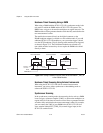
Chapter 2 Using the SCXI-1127/1128
SCXI-1127/1128 User Manual 2-12 ni.com
SCXI-1127/1128. In its simplest form, hardware-timed scanning uses one
triggering signal to advance the multiplexer to the next channel in the scan.
This is called synchronous scanning.
Note
When using a DMM with the SCXI-1127/1128, synchronous mode is the only mode
in which the DMM and the SCXI-1127/1128 operate.
Another hardware-timed scanning method is called handshaking. While
synchronous scanning requires just one signal from the instrument to the
multiplexer, handshaking requires an additional signal connected from the
multiplexer to the instrument. This additional trigger, SCANADVD,
notifies the measuring instrument that the multiplexer has settled and the
next measurement can be made. This method is useful when using an
SCXI-1127/1128 with external instruments to guarantee that both the
measurement instrument and the multiplexer have settled before taking
the next measurement.
The second type of scanning, software scanning, is a method by which
channels are selected through the software. This method requires no trigger
connections. Software scanning does not offer the time accuracy of
hardware-timed scanning.
Hardware-Timed Scanning
In hardware-timed scanning, the software downloads to the
SCXI-1127/1128 a list of channels to scan, including each channels
configuration information, such as whether the channel is 2-wire, 1-wire,
or 4-wire. The software then arms the SCXI-1127. Once armed, the
SCXI-1127/1128 advances to the next channel when it receives a trigger
from the DMM. In multi-module scanning, the chassis arbitrates between
modules. Each module in turn drives its output onto the analog bus and on
the OUT (COM) terminals. Figure 2-11 shows the hardware scanning
flowchart and may be useful in understanding the scanning/triggering
operation of the SCXI-1127/1128.


















